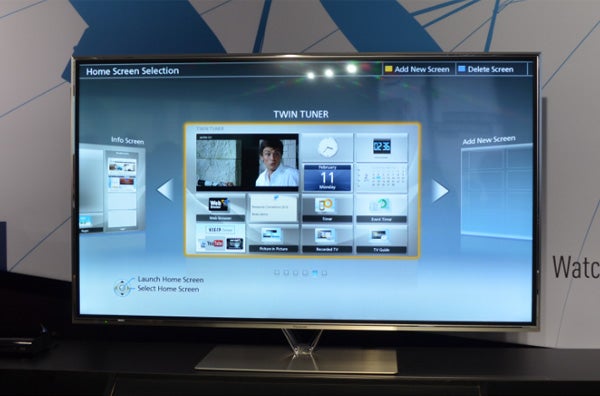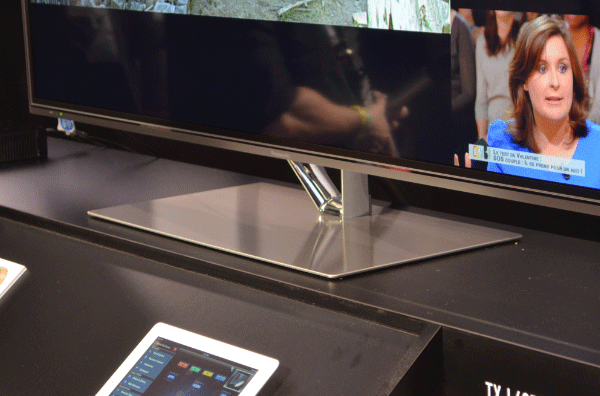Panasonic TX-L60DT60 Review
Panasonic TX-L60DT60
A giant 60-inch LED TV with voice recognition and dual tuners.

Verdict
Key Specifications
- 60-inch 1080p LED-backlit panel
- my Home Screen UI
- SD memory card slot
- Wi-Fi
The Panasonic TX-L60DT60 is the largest in the 2013 DT60 range. It’s a 60-inch LED TV. We weren’t too impressed with its 2012 brother, the Panasonic TX-L47DT50, and we took a closer look at this year’s model to see if it’s any better.
Panasonic TX-L60DT60 – Design
Fans of Panasonic’s LED TVs will notice the familiar design right away. The Panasonic TX-L60DT60 has a slim silver bezel and an attractive brushed metal pedestal stand.
The bottom of the Panasonic TX-L60DT60’s fascia is, like most of Panasonic’s LED models, finished with a lip of transparent plastic. It’s a good-looking telly, and at 27.5kg it’s a good deal lighter than Plasma models of a similar size. That said, trying to lug this thing around by yourself is a short road to back pain.
Panasonic TX-L60DT60 – Connectivity and Features
On the Panasonic TX-L60DT60’s side, you’ll find a trio of HDMI ports and an SD memory card slot. It’ll play all sorts of media files from a card, or an HDD hooked up to the USB slot, including downloader-favourite MKV. It’s the features you don’t see that impress, though.
The Panasonic TX-L60DT60 features integrated Wi-Fi and dual tuners – that’s dual Freeview HD and dual Freesat HD tuners, so technically four in total.
The TV’s new my Home Screen interface makes it easy to get PiP previews of channels within the “discreet home screen” EPG, and lets you record two channels at once. You’ll need to hook up a hard drive for this recording feature, though, as the Panasonic TX-L60DT60 doesn’t feature one itself. 
Using the new my Home screen software, the Panasonic TX-L60DT60 offers face recognition, to take you quickly to your own home screen, but again an accessory is needed. Panasonic offers a webcam that attaches to the screen. You’ll find this included in the design of the pricier WT models.
All kinds of other software bells and whistles are included in my Home Screen too, such as streaming to Android tablets or iPads, voice recognition using a mic built into the remote, and a web browser. We’re not convinced most buyers will get all that much use out of these additional features, but the quad-core processor running the show makes the Panasonic TX-L60DT60 interface fly along quickly enough, ensuring they don’t feel laboured.
Panasonic TX-L60DT60 – Image Quality and Screen
The Panasonic TX-L60DT60 uses a 60-inch IPS-based LED-backlit screen. This offers the excellent viewing angles associated with this panel type, as well as the strong brightness of an LED backlight. But will the Panasonic TX-L60DT60 really improve upon the lacklustre performance of its predecessor DT50 range?
One reassuring feature is the use of localised dimming. The Panasonic TX-L60DT60 uses a 6-block panel, allowing six different areas of backlight intensity throughout the screen. This is there to improve contrast, although the model-up WT series’s use of a 16-block screen shows that the DT60 still isn’t a truly high-end model. However, it uses the new Hexa-Processing engine, which offers six image enhancement models, accessible through the TV’s settings menu.
Like the majority of 2013 Panasonic TVs, the Panasonic TX-L60DT60 uses a passive 3D system, a departure from the Active type seen in previous generations of the DT series. A spokesperson explained that 3D is no longer a great priority, saying that the average viewer is likely to be just as happier with passive – more so given they’ll no longer have to pay out for pricey Active 3D glasses.
We’ll be back with the full verdict on the Panasonic TX-L60DT60 in our review.
How we test televisions
We test every TV we review thoroughly over an extended period of time. We use industry standard tests to compare features properly. We’ll always tell you what we find. We never, ever, accept money to review a product.


